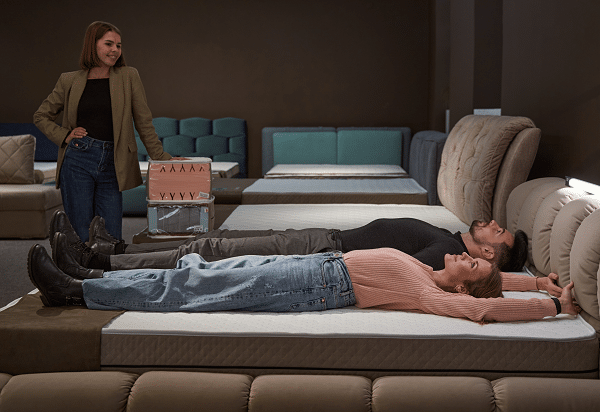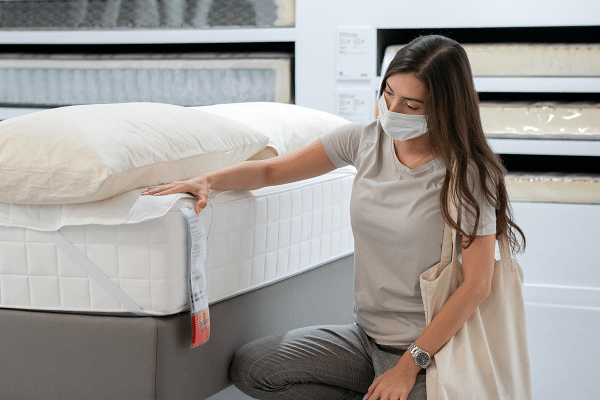How do you find the right mattress for you? It can be difficult, especially if you don’t know where to start. This blog post will outline some tips to help make the process easier. We will also discuss different types of mattresses and how they may suit different people. So, whether you are looking for your first mattress or are just curious about the process, read on!
Contents
Mattress Types

If you’re getting started looking for a new mattress, you’ve undoubtedly encountered a plethora of choices. Thinking about mattress sorts is an excellent method to get your bearings. Foam, innerspring, hybrid, latex, and airbeds are the most popular types of beds. Innersprings have long been the standard in American homes. However, other mattress kinds have grown in popularity in recent years.
- Foam: These mattresses are entirely foam and do not have any coils. They give more excellent contouring to the body, pressure relief, and motion isolation than other foams, making them ideal for side sleepers and couples. Memory foam is one of the most well-known foams in these beds.
- Innerspring: A coil-based support system and a few other components make up an innerspring mattress. While the coils provide some support, the innerspring typically lacks pressure relief. Their sleeping surface is bouncier and has less motion isolation than those of high-density mattresses. Budget buyers favor these because they are cheaper than foam mattresses.
- Hybrid: A hybrid mattress contains coils and foam, such as memory foam or latex. They aim to combine the best features of an innerspring and a foam mattress by providing good bounce, airflow, and pressure relief. However, hybrids can be expensive, and some people find them too hot.
- Latex: A latex mattress consists of natural or synthetic rubber. They are known for being durable, breathable, and pressure relieving. Latex mattresses often come in two types: Dunlop and Talalay. Dunlop is denser and has a firmer feel, while Talalay is more elastic and softer.
- Airbed: Airbeds are filled with air, and you can customize them to your desired firmness. They often have a memory foam layer on top for added comfort. Airbeds offer good pressure relief but may not be as durable as other mattress types.
Choosing The Right Mattress For Back Pain

Back discomfort can be caused by various factors, but you should not overlook an ill-fitting mattress. Proper support may prevent pain from developing in individuals without back problems, and the appropriate mattress might assist with cushioning and comfort for those who already have back problems. Choosing the ideal mattress for back pain entails assessing the nature of the pain and other mattress demands and preferences.
Back discomfort that strikes suddenly is known as acute back pain. Back issues can begin as acute before evolving into chronic over time, such as after an injury or following surgery. Side sleepers should generally search for mattresses with medium-soft to medium-firm impact cushions. Back and stomach sleepers should look for firm beds yet only slightly conform to their shape.
Sleeping Positions

What is your sleeping position when you’re ready to fall asleep? And what posture do you find yourself in when you wake up? The parts of your body that require additional support in order to keep your spine straight change depending on your sleeping posture. As a result, choosing a mattress according to your sleeping postures may improve comfort and prevent pain.
- Back Sleepers: Back sleepers put the most strain on their lower backs. If a mattress is too soft, the torso may sink in more than the upper back and lower body, putting strain on it. A mattress that is too firm will not provide for enough concavity in the slightly bent lower back. Back sleepers do best with a medium-firm to the firm mattress.
- Side Sleepers: Side sleepers need a mattress that provides support along the length of their bodies to keep the spine straight. They also need a softer surface to avoid pressure points in the hips and shoulders. A too-soft mattress will not provide enough support, while a too firm mattress will cause pain in these areas. Side sleepers should look for a mattress with a medium to soft firmness rating.
- Stomach Sleepers: Stomach sleepers put the most strain on their necks, and they require the least amount of support. A soft mattress will cause the head and neck to sink, leading to discomfort. Conversely, a very firm mattress will not provide enough give in the hips and may cause pain. Stomach sleepers should look for a mattress with a medium to firm firmness rating.
Body Types

The body shape and weight of a person influence the selection of the best mattress for spinal support, comfort, and other vital characteristics. People who weigh less than 130 pounds sink farther into a mattress due to their slimmer profile. Because of its softer profile, people that weigh less than 130 pounds do not sink as far into a bed.
People between 130 and 230 pounds usually find the best results with mattresses with a medium-firm to firm rating. A mattress that is too soft will not provide enough support, while a too firm mattress may cause discomfort. These people should also consider hybrid or foam mattresses because they tend to contour well to the body while still providing support. Latex mattresses are also an option for people in this weight group because they offer excellent support and pressure relief.
Foam, hybrid, and latex mattresses are all durable choices that you may pick depending on their particular characteristics and designs. Individuals over 230 pounds will sink further into a mattress, especially around heavier sections of the body, which can put off spinal alignment. These sleepers have typically had better results with mattresses that are a bit firmer to help with spinal alignment and pressure relief. Heavy people also prefer mattresses with thicker comfort layers because they add more cushioning. Hybrid mattresses that have a thick layer of coils are also an option for heavyweight sleepers. Lastly, latex mattresses are known for their excellent support and durability, making them another viable option for people in this weight group.
Pricing

A mattress is a significant investment in your comfort since it’s the piece of furniture that’s almost certain to be used the most. At the same time, it may be a substantial financial commitment, and the price is an important consideration when purchasing one. Most consumers should consider their entire bedroom budget when determining how much to spend on a new mattress. This covers everything, including a new mattress and any other necessities, such as fresh pillows or bedding.
Mattresses range in price from low-cost, low-quality models to high-end designer beds. Most mattresses cost between $600 and $2,000, with outliers such as luxury versions and budget-friendly options falling outside this range. The type of mattress you choose will impact the overall price. Innerspring mattresses are typically less expensive than memory foam or latex versions.
Conclusion
Overall, the best way to find the right mattress is to think about how you sleep and what type of sleeper you are. Consider your budget, body type, and other needs when deciding. There are many different mattresses on the market, so it’s important to research before purchasing one. With a little time and effort, you’re sure to find the perfect bed for you and your family.



